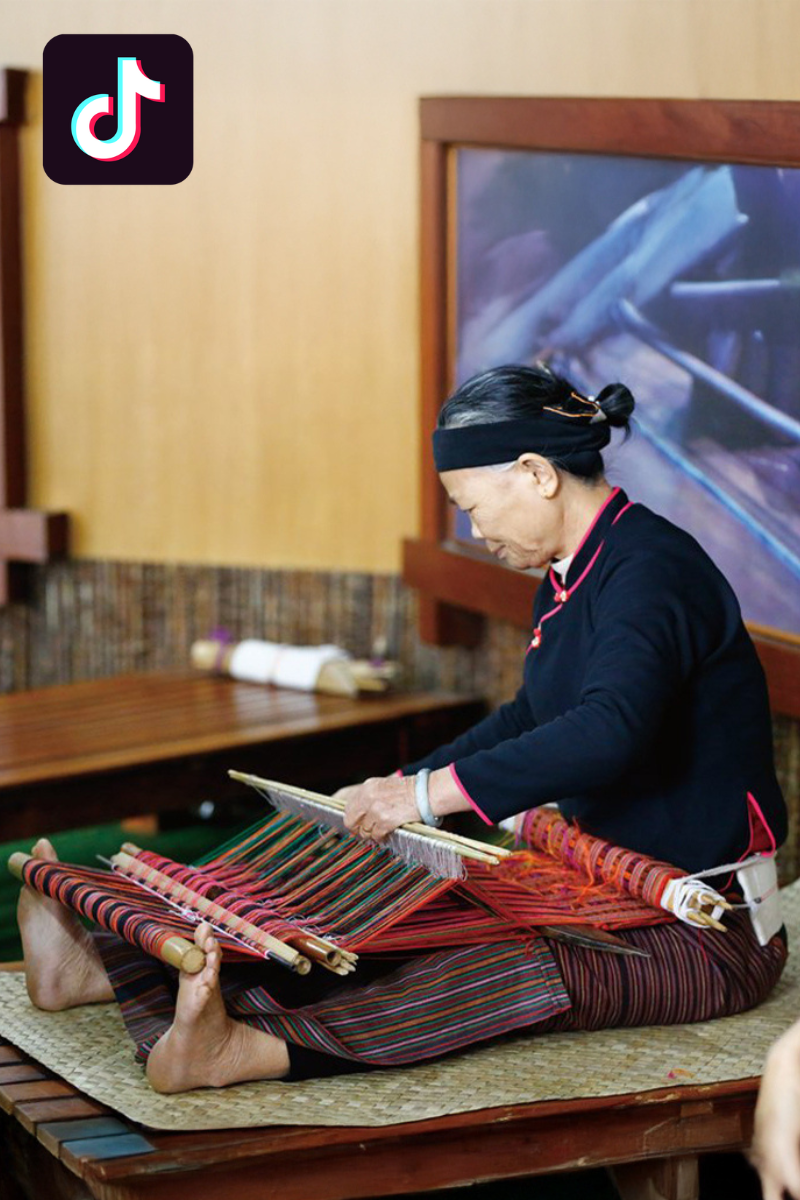The Analog Wisdom in Digital Formats
Traditional textile craftsmanship operates on principles that predate industrial manufacturing by millennia. The elderly artisan in the video represents knowledge systems developed through direct transmission—teacher to student, generation to generation, with refinements accumulated across countless iterations. Her navy garment and red head covering aren't costume choices; they reflect regional traditions where specific colors and styles indicate expertise levels and cultural affiliations within craft communities.
The decorative trim application visible in the video demonstrates techniques that modern fashion education often treats as advanced specializations. Hand-applied trim requires understanding of fabric grain direction, tension control, and seam finishing that parallels the princess seam construction used in contemporary bespoke tailoring. The precision evident in her work—consistent stitch length, perfect edge alignment, uniform thread tension—represents mastery that industrial production cannot replicate, regardless of technological advancement.
This level of craftsmanship traditionally remained invisible to consumers who encountered only finished products. Short video platforms change that dynamic by making process visible, allowing viewers to witness the human skill investment that separates handcrafted work from mass production. The visual immediacy creates appreciation that lengthy explanations struggle to achieve, much like how witnessing a live jazz performance reveals musical complexity that recorded versions cannot fully convey.
Platform Mechanics Reshaping Craft Discourse
Douyin and TikTok algorithms favor content that maintains viewer attention throughout the complete viewing duration. This technical requirement forces craft documentation to focus on the most visually compelling aspects of traditional techniques—the moments where skill becomes most apparent. The elderly woman's trim application succeeds as content because it showcases manual dexterity and precision timing that viewers can immediately recognize as requiring significant expertise.
The sixty-second format eliminates the luxury of extended explanation, compelling creators to distill processes to their most essential elements. This constraint produces content that mirrors how master craftspeople actually teach—through demonstration rather than theory, emphasizing muscle memory and visual pattern recognition over verbal instruction. The format accidentally replicates traditional apprenticeship learning methods within digital distribution systems.
Comment sections become sites of cultural exchange where viewers from different geographical regions compare techniques, share variations, and debate methodology. These discussions often reveal how similar problems—fabric stabilization, edge finishing, decorative application—receive different solutions across cultures, creating informal databases of traditional knowledge that academic institutions struggle to compile through conventional research methods.
Technical Translation: Screen to Workroom
The craftsmanship techniques visible in these videos translate directly to contemporary tailoring practices, though the connection often remains unrecognized. The hand-sewn trim application demonstrated by the elderly artisan employs the same fundamental principles used in high-end menswear for lapel edge finishing and pocket trim installation. Both require precise fabric preparation, controlled thread tension, and consistent stitch placement to achieve professional results.
Modern bespoke tailoring can learn from the visible techniques in traditional craft videos. The elderly woman's finger positioning while guiding thread reveals ergonomic approaches that reduce hand fatigue during extended sewing sessions. Her fabric handling demonstrates grain awareness that prevents distortion during construction—knowledge that separates superior tailoring from competent but pedestrian work.
The decorative trim shown in the video requires techniques that parallel French seaming and Hong Kong finishes used in luxury garment construction. Both approaches prioritize clean, durable edge treatment that maintains appearance integrity throughout the garment's lifespan. The visual similarity isn't coincidental; both represent solutions to identical technical challenges, developed independently across different cultural contexts but arriving at comparable results through practical necessity.
Cultural Authority Through Digital Documentation
These short videos establish cultural authority in ways that traditional credentialing systems cannot match. The elderly woman's expertise becomes apparent through visual demonstration rather than institutional validation. Viewers recognize skill through direct observation, creating appreciation based on actual capability rather than assumed qualifications. This represents a shift toward competence-based authority that parallels how the early internet allowed technical expertise to supersede institutional gatekeeping.
The platform's global reach exposes traditional techniques to audiences who might never encounter such craftsmanship through conventional channels. Fashion students in urban centers witness rural artisans employing techniques that formal education programs omit from curricula. Professional tailors discover historical methods that inform contemporary problem-solving. Amateur enthusiasts gain appreciation for skill levels that distinguish genuine craftsmanship from superficial imitation.
This democratization of craft knowledge creates new forms of cultural exchange that circumvent traditional barriers. Geographic distance, language differences, and economic limitations that historically prevented cross-cultural learning become less significant when technique demonstration transcends verbal communication. The visual nature of the content allows knowledge transfer that written instructions or translated explanations often fail to achieve effectively.
The Reset Button: Accelerated Appreciation Cycles
Traditional craft appreciation developed through extended exposure—apprentices spent years observing masters before attempting complex techniques independently. Short video platforms compress this timeline dramatically, allowing viewers to witness advanced techniques within minutes of discovering particular crafts. This acceleration changes how people relate to traditional knowledge, creating instant awareness of skill levels that previously required prolonged engagement to recognize.
The elderly woman's video reaches audiences who possess no background in textile work but can immediately recognize the precision and control her movements demonstrate. This rapid skill recognition creates appreciation that might eventually translate into deeper engagement with traditional crafts. The platform functions as a discovery mechanism that introduces traditional techniques to populations who might never encounter them through conventional educational pathways.
However, this accelerated exposure also creates challenges for traditional learning systems. Viewers who gain appreciation through short videos sometimes overestimate their readiness to attempt complex techniques independently. The compression that makes content engaging also eliminates the foundational knowledge typically required before attempting advanced work. Master craftspeople must adapt teaching methods to address students who arrive with visual familiarity but lack fundamental understanding of underlying principles.
Algorithm Influence on Craft Presentation
Platform algorithms shape how traditional crafts get presented to global audiences, inadvertently influencing which techniques receive attention and which remain obscure. The elderly woman's trim application succeeds as content because it provides clear visual progression within the time constraints. More subtle techniques—fabric preparation, tool maintenance, quality assessment—receive less platform attention because they lack immediate visual appeal, despite their fundamental importance to craft practice.
This algorithmic selection creates distorted representations of traditional crafts that emphasize spectacular technique over foundational knowledge. Viewers develop appreciation for advanced applications while remaining unaware of the preparatory work that makes such techniques possible. The result resembles how highlight reels create athletic appreciation without conveying the training requirements that enable peak performance moments.
Content creators adapt to algorithm preferences by structuring demonstrations around platform requirements rather than pedagogical logic. Traditional teaching sequences get reorganized to maximize viewer retention, sometimes separating techniques from their proper contexts or eliminating steps that appear visually redundant but serve important functional purposes. This adaptation changes how traditional knowledge gets transmitted, with platform mechanics influencing cultural preservation in unexpected ways.
The Thick Skin Philosophy: Durability Through Digital Preservation
Short video documentation creates permanent archives of traditional techniques that might otherwise disappear with their practitioners. The elderly woman's demonstration becomes part of a digital repository that preserves her specific approach to trim application for future reference. This preservation occurs automatically through platform infrastructure, requiring no institutional support or formal documentation processes.
The durability extends past simple archival function. These videos create reference materials that practitioners can consult repeatedly, reviewing specific hand positions or timing details that might be forgotten between learning sessions. Traditional apprenticeship relied on memory and repeated observation; digital documentation allows precise technique review that supports more effective skill development.
Platform preservation also enables comparative analysis across different practitioners and regional variations. Viewers can study multiple approaches to similar techniques, identifying common elements and regional adaptations that reveal underlying principles. This comparative capability exceeds what traditional learning environments could provide, creating opportunities for technique refinement that individual masters might not achieve working in isolation.
Global Craft Networks Through Local Knowledge
The elderly woman's video represents local knowledge that gains global relevance through digital distribution. Her specific techniques reflect regional traditions developed within particular cultural contexts, but the underlying principles apply across different textile traditions. Viewers from various cultural backgrounds recognize universal elements within her specific practice, creating connections that transcend cultural boundaries while maintaining respect for cultural specificity.
These connections generate informal networks where practitioners share variations, adaptations, and innovations inspired by traditional techniques. Contemporary tailors incorporate historical methods into modern garment construction. Fashion students explore traditional approaches that inform design decisions. Amateur enthusiasts develop appreciation that supports traditional craft preservation through increased interest and engagement.
The networking effect creates economic opportunities for traditional craftspeople who can reach global markets through platform visibility. The elderly woman's demonstration of skill might generate interest in her work that extends past the platform, creating income streams that support continued craft practice. This economic dimension helps sustain traditional techniques by making them financially viable for practitioners in contemporary economic contexts.
Contemporary Applications: Traditional Knowledge in Modern Practice
Modern tailoring can incorporate techniques visible in traditional craft videos without appropriating cultural elements inappropriately. The hand-sewing precision demonstrated by the elderly artisan informs approaches to contemporary garment construction that prioritize quality and durability over production speed. Her fabric handling reveals principles that improve modern work regardless of cultural context.
The decorative trim application shown in the video translates directly to contemporary formal wear construction. Lapel trim, pocket details, and seam finishing benefit from the same attention to edge preparation and stitch consistency that her traditional work demonstrates. These applications enhance modern garments while respecting the cultural contexts from which the techniques originated.
Contemporary fashion education can integrate traditional technique documentation into curricula that address historical methods alongside modern practices. Students gain appreciation for technique development across cultures while learning applications that enhance their contemporary work. This integration creates more comprehensive technical education that acknowledges the cultural foundations underlying modern garment construction practices.
Advanced Integration: Platform Learning in Professional Development
Professional tailors increasingly use short video platforms for continuing education that supplements formal training. The concentrated technique demonstrations provide visual references that support skill development in ways that written instructions cannot match. Practitioners can study specific hand positions, timing sequences, and tool applications that refine their existing capabilities.
The global access enables learning from practitioners who might be geographically inaccessible through traditional educational pathways. Regional techniques that developed within specific cultural contexts become available for study and adaptation by practitioners worldwide. This access creates opportunities for technique cross-pollination that enriches contemporary practice while maintaining respect for cultural origins.
Platform learning also enables peer education networks where practitioners share innovations, troubleshoot challenges, and develop techniques collaboratively. The comment sections and response videos create ongoing dialogues about craft practice that extend past individual demonstrations. These interactions generate collective knowledge that benefits the broader community of practitioners engaged with traditional techniques.
Future Implications: Digital Craft Preservation and Innovation
The intersection of traditional crafts and digital platforms suggests future developments that could transform how cultural knowledge gets preserved and transmitted. The elderly woman's demonstration represents current capabilities, but emerging technologies might enable more sophisticated documentation that captures subtle aspects of traditional techniques currently invisible to standard video recording.
Advanced documentation could preserve sensory information—fabric texture, thread tension, tool weight—that influences technique execution but remains inaccessible through visual documentation alone. This enhanced preservation would create more complete archives of traditional knowledge that support more effective learning and cultural preservation efforts.
The global networks developing around traditional craft appreciation might evolve into formal educational institutions that combine digital access with traditional mentorship structures. Practitioners could receive foundational training through platform content while developing advanced skills through direct apprenticeship with masters whose work they discovered through short video platforms.
Contemporary craft appreciation, accelerated through digital platforms, creates new relationships between traditional knowledge and modern practice. The elderly woman's steady hands applying decorative trim represent centuries of accumulated wisdom now accessible to global audiences within sixty-second viewing experiences. This compression doesn't diminish the craft's complexity but makes its sophistication visible to people who might never encounter such artistry through conventional channels.
The platforms function as cultural bridges that connect traditional knowledge systems with contemporary appreciation mechanisms, creating opportunities for cross-cultural learning that respect cultural specificity while acknowledging universal elements within craft practice. These connections generate new forms of cultural exchange that benefit both traditional practitioners and contemporary audiences seeking authentic engagement with human skill and creativity.
The result represents evolution rather than replacement—traditional apprenticeship systems continue functioning within their cultural contexts while digital documentation creates supplementary learning opportunities that extend access without diminishing authenticity. The elderly woman's demonstration preserves her specific knowledge while inspiring appreciation that supports continued craft practice across cultural boundaries, creating sustainable models for traditional knowledge preservation in digital contexts.




